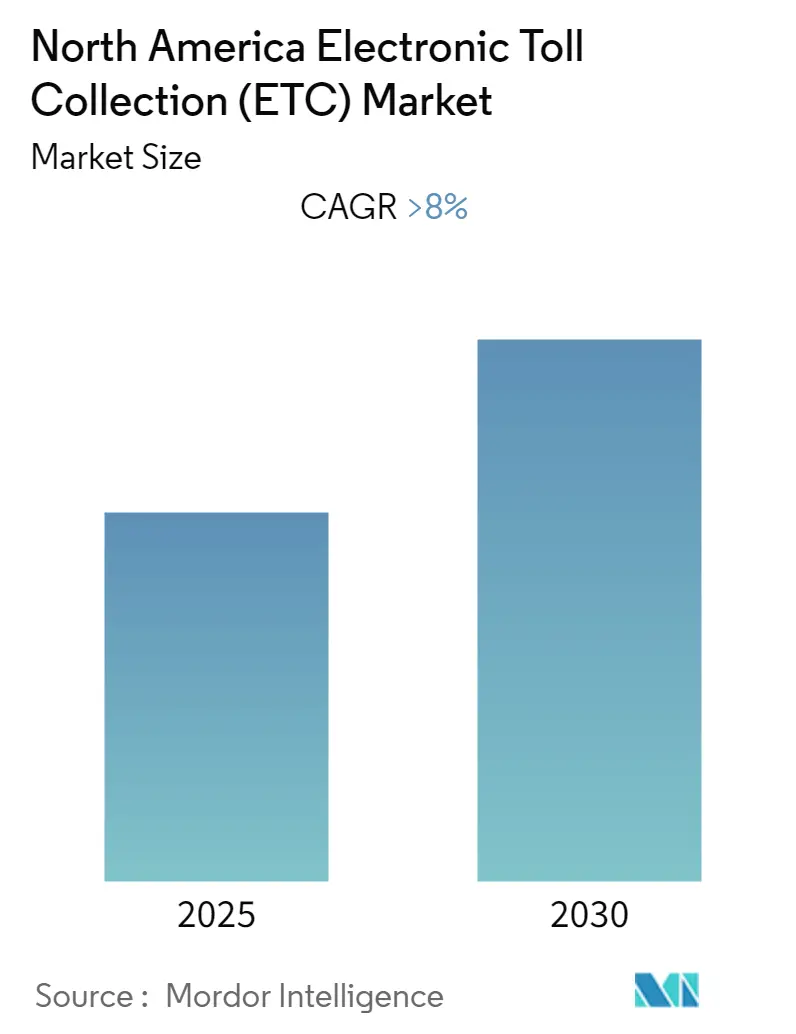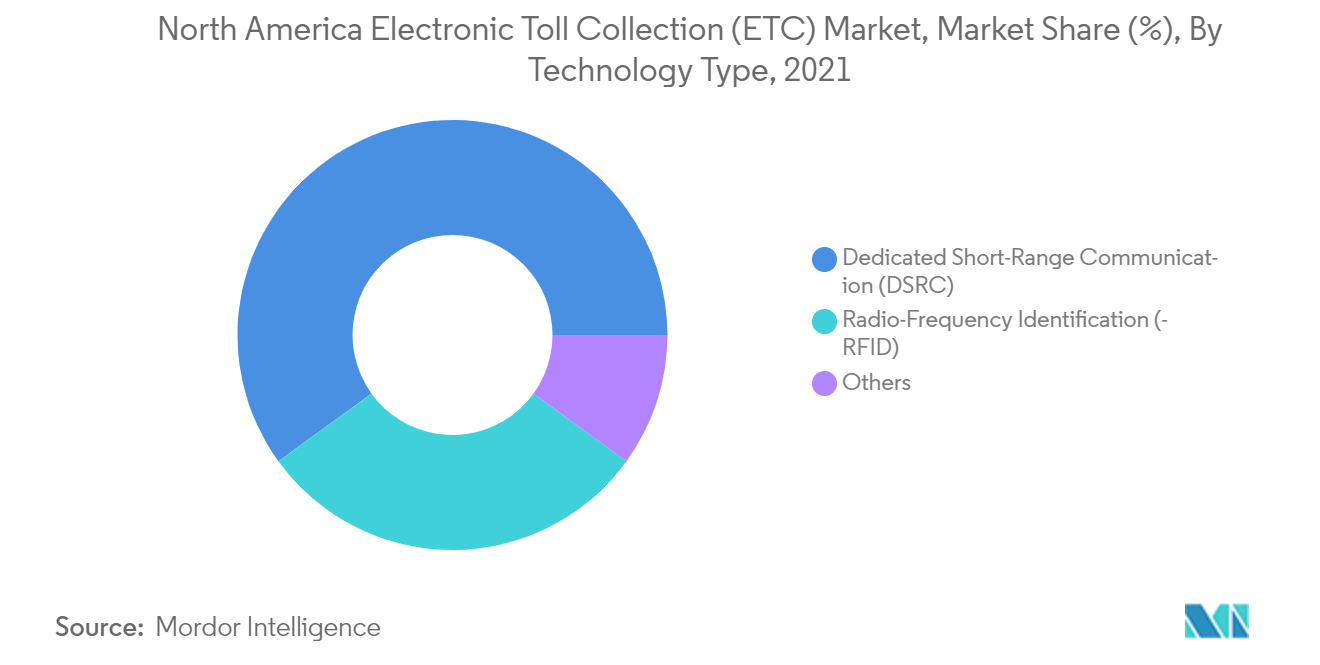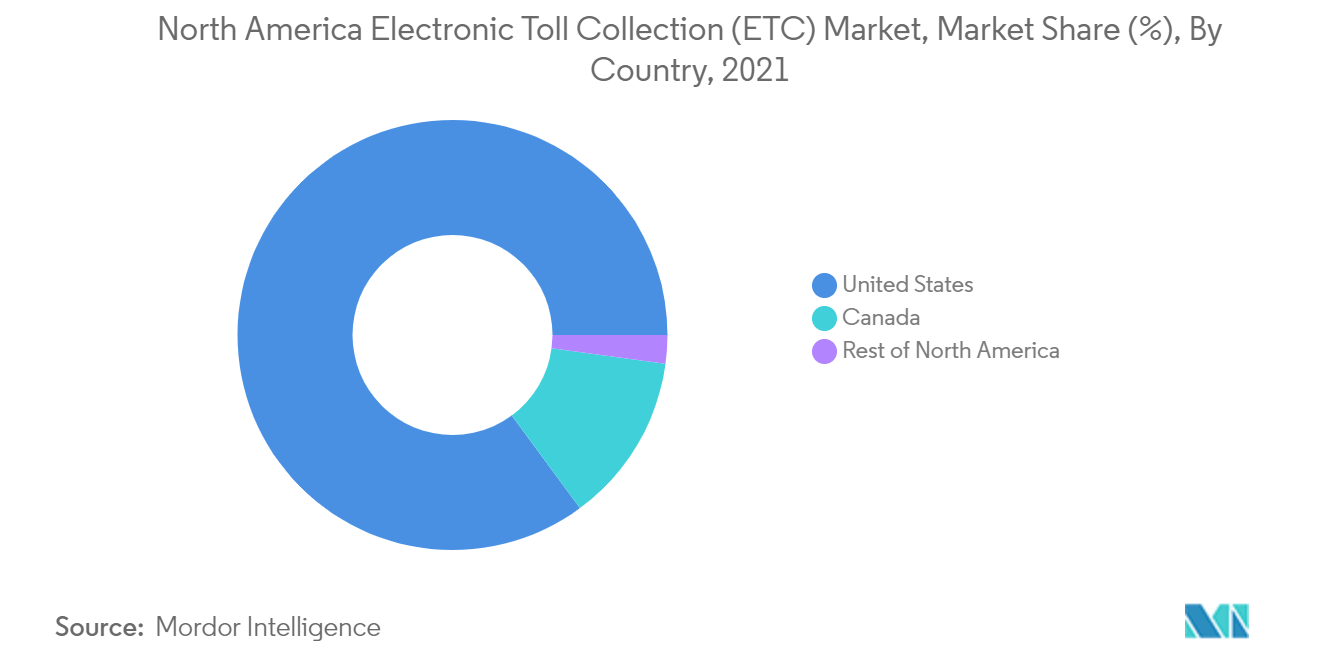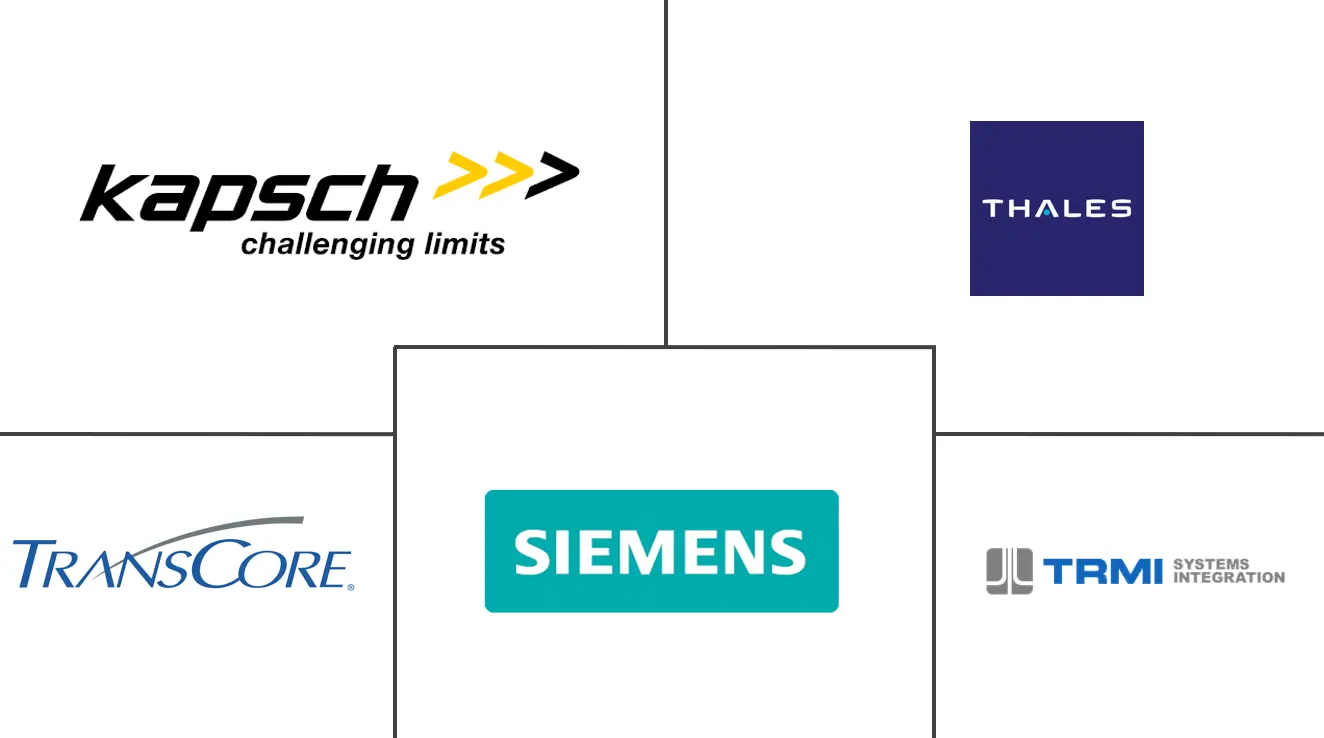North America Electronic Toll Collection (ETC) Market Size and Share

North America Electronic Toll Collection (ETC) Market Analysis by Mordor Intelligence
The North America Electronic Toll Collection Market is expected to register a CAGR of greater than 8% during the forecast period.
The COVID-19 pandemic has severely impacted several industries across the world, causing an economic slowdown. Many industries took a hit due to countries imposing lockdowns and restrictions to stop the spread of the virus. As economies are recovering slowly, it is expected that the market will grow during the forecast period, 2022-2027.
Factors like the rising number of government initiatives to achieve congestion-free transportation, growing investments in road infrastructure, rapidly increasing vehicle demand and production in the North American region, and adoption of the latest technological solutions, including GPS and GNSS toll collection and tracking solutions, are expected to drive the market forward.
Toll roads provide an alternative method of financing transportation construction costs. Toll facilities include toll roads, tunnels, and bridges. The toll is traditionally due when people pass a collection point in the form of a plaza or a booth in the case of an open road facility (ORT). In the last few years, advancements in technology have been redefining toll collection systems in the North American region.
The demand for electronic toll collection is growing significantly, as it majorly helps reduce traffic at tollbooths by collecting tolls without cash and without requiring the vehicles to stop. Also, various state governments are planning to open new toll roads due to scarcity of funds in the transportation sector and stagnant gasoline tax rates. Most toll facilities in the United States today use an electronic toll collection system as an alternative to paying cash. Many states have implemented open road tolling, which eliminates the need to stop at toll booths.
The continuously growing toll collection technology is helping to automate the toll collection process and avoid long queues at toll booths. Additionally, these technologies not only aid in vehicle theft detection, but they can also track the vehicles crossing the signal and over-speeding vehicles. The trend of shifting from barrier-based ETC to open road tolling (ORT) or fee flow tolling has been gradually growing in the road tolling industry, especially in states facing high traffic congestion at toll roads.
North America Electronic Toll Collection (ETC) Market Trends and Insights
Technological Advancement of Electronic Toll Collection Systems
The traffic congestion at toll plazas has been increasing with respect to vehicle sales every year. An increase in people's preference to use their own vehicle over public transport is also the reason behind traffic at tolls. An increasing number of vehicles on the roads results in many problems, such as congestion, air pollution, and fuel wastage. Owing to the above reasons, governments have transitioned toward electronic toll collection. In the United States, due to advancements in communication technology and contactless payment platforms, this phenomenon has been clearly evident over the years. Now, this process is being implemented in other countries in the North American region.
Apart from ensuring funds for expansion and maintenance of roads and highways, collection of tolls, especially by the electronic method, offers numerous benefits, such as:
- Limited or no traffic congestion
- Fuel efficiency of vehicles and reduction in exhaust emissions by reducing or eliminating deceleration, acceleration, and waiting time
- Vehicle theft detection
- Tracking over-speeding vehicles and vehicles crossing the signal
In the United States, EZ pass tags have become widely accepted across 17 states. EZ pass tags made by Kapsch TrafficCom are facilitating open road tolling. According to the company, more than 35 million EZ pass devices are in circulation across the country. Sunpass and FasTrack are some other types of toll tags that do not accept EZ passes across various tolls in states like Florida.

The United States Led the Electronic Toll Collection Market
The electronic toll collection market in the United States is expected to grow at a faster pace as various state governments are planning to open new toll roads and highways due to scarcity in funds from the transportation sector and stagnant gasoline tax rates. For instance:
- In June 2021, President Biden's infrastructure plan, which would cost about USD 2 trillion, included USD 50 billion in funds to improve 20,000 miles of streets and highways. The plan proposes a similar approach for 10,000 bridges, backed by USD 40 billion. If implemented, the plan could bring new toll roads and highways across the country.
- In 2020, the Florida Legislature conceived a program to create three new toll roads totaling 330 miles across Florida's hinterlands, the largest toll-road project in the country.
Canada is also planning to upgrade its hardware and software systems in the existing toll facilities. For instance, in 2020, the Transportation Ministry of Canada introduced the Alberta bill that would enable the use of tolls to finance new bridge and road projects. Further, the Financing Alberta's Strategic Transportation (FAST) Act would allow the government to use tolls to finance new roads and bridges.

Competitive Landscape
The North America electronic toll collection market is led by a few major players such as Kapsch Group, Thales Group, Toshiba Corporation, TransCore, Siemens, TRMI Systems Integration, Magnetic AutoControl, etc.
The companies are launching more advanced products to have the edge over market competitors. For instance:
- In November 2020, Kapsch announced that it had developed an all-new electronic tolling (AET) system for the New York State Thruway Authority (NYSTA), which is now fully operational and in revenue service.
- In July 2020, TransCore delivered a program that advances tolling capabilities in California by leveraging real-time occupancy meters to enhance enforcement, alleviate congestion, and provide solo drivers with clean-air discounts when applicable.
North America Electronic Toll Collection (ETC) Industry Leaders
Kapsch Group
Thales Group
TransCore
Siemens
TRMI Systems Integration
- *Disclaimer: Major Players sorted in no particular order
.webp)
Recent Industry Developments
- In December 2021, Quarterhill Inc announced that its wholly-owned subsidiary, Electronic Transaction Consultants, LLC ("ETC"), had received an award notice from the Central Texas Regional Mobility Authority ("CTRMA") in Austin, Texas, to provide electronic toll collection integration and maintenance services. The contract's initial term is six (6) years, with two (2) two-year extension options. The contract's initial six-year term is worth USD 72,791,680, and it's subject to standard terms and conditions.
- In June 2021, Plenary Infrastructure Group (Plenary) granted Kapsch TrafficCom (Kapsch) a contract to develop a new toll collecting system for the Louisiana Highway (LA-1) for the Louisiana Department of Transportation and Development (LADOTD). The project is an addition to Kapsch's existing contract with Plenary, which calls for the company to provide an end-to-end all-electronic tolling system as well as related maintenance services for a major bridge and tunnel replacement in Belle Chasse, Louisiana.
- In May 2021, New York's Metropolitan Transportation Authority awarded contracts totaling almost USD 400 million to three firms to run different aspects of toll system operations at its bridges and tunnels. Conduent was awarded an eight-year USD 246 million contract to design and maintain an upgraded system for its transponder-based toll collection system, known as E-ZPass. Faneuil Inc. got awarded a five-year USD 122 million contract to set up tolling operation centers and maintenance. Transcore LP was awarded a five-year USD 26 million contract to distribute and manage transponders.
North America Electronic Toll Collection (ETC) Market Report Scope
Electronic toll collection (ETC) is a wireless system to automatically collect the usage fee or toll charged to vehicles using toll roads, HOV lanes, toll bridges, and toll tunnels. Vehicles using the system are equipped with an automated radio transponder device. When the vehicle passes a roadside toll reader device, a radio signal from the reader triggers the transponder, which transmits back an identifying number that registers the vehicle's use of the road, and an electronic payment system charges the user the toll.
The North America electronic toll collection (ETC) market can be segmented on the basis of type, technology, application, and geography. Based on type, the market is segmented into the transponder and other types. By technology, the market is segmented into radio-frequency identification (RFID), dedicated short-range communication (DSRC), and other technologies. By application type, the market is segmented into bridges, roads, and tunnels. By geography, the market is segmented into the United States, Canada, and Rest of North America.
The report also covers the market size and forecast for the North America Electronic Toll Collection (ETC) Market across the regions mentioned. For each segment, the market sizing has been done in terms of value (USD billion).
| Transponder |
| Other Types |
| Radio-frequency Identification (RFID) |
| Dedicated Short-range Communication (DSRC) |
| Other Technologies |
| Bridges |
| Roads |
| Tunnels |
| United States |
| Canada |
| Rest of North America |
| Type | Transponder |
| Other Types | |
| Technology | Radio-frequency Identification (RFID) |
| Dedicated Short-range Communication (DSRC) | |
| Other Technologies | |
| Application Type | Bridges |
| Roads | |
| Tunnels | |
| Geography | United States |
| Canada | |
| Rest of North America |
Key Questions Answered in the Report
What is the current North America Electronic Toll Collection (ETC) Market size?
The North America Electronic Toll Collection (ETC) Market is projected to register a CAGR of greater than 8% during the forecast period (2025-2030)
Who are the key players in North America Electronic Toll Collection (ETC) Market?
Kapsch Group, Thales Group, TransCore, Siemens and TRMI Systems Integration are the major companies operating in the North America Electronic Toll Collection (ETC) Market.
What years does this North America Electronic Toll Collection (ETC) Market cover?
The report covers the North America Electronic Toll Collection (ETC) Market historical market size for years: 2019, 2020, 2021, 2022, 2023 and 2024. The report also forecasts the North America Electronic Toll Collection (ETC) Market size for years: 2025, 2026, 2027, 2028, 2029 and 2030.
Page last updated on:
North America Electronic Toll Collection (ETC) Market Report
Statistics for the 2025 North America Electronic Toll Collection (ETC) market share, size and revenue growth rate, created by Mordor Intelligence™ Industry Reports. North America Electronic Toll Collection (ETC) analysis includes a market forecast outlook for 2025 to 2030 and historical overview. Get a sample of this industry analysis as a free report PDF download.



